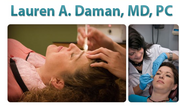
Age spots, also called liver spots, are flat patches of skin with extra pigmentation. Some people think they’re unsightly, but they also point to more pressing concerns—too much sun exposure. If you’re fair-skinned or prone to sunburn, here’s what you should know about age spots and how to prevent them, according to a skin surgeon.
Questions About Age Spots Answered
What are age spots?
Exposure to ultraviolet (UV) light increases the amount of melanin in your skin. Melanin is a harmless pigmentation that can appear in your skin, eyes, and hair—it's what causes some people to have tan skin and brown eyes, for example.
What causes them?
Age spots usually start to emerge around 50 years of age, which is when the outer layer of the skin (the epidermis) gets thinner and becomes more translucent. If your skin is naturally pale, these changes can reveal underlying sun damage.
Although sun spots aren’t intrinsically dangerous, damage caused by frequent sun exposure can increase your risk of skin cancer. It will also dramatically accelerate any signs of aging by impairing the elastin fibers in your skin. This could manifest as loose, sagging skin, wrinkles, and easy bruising and cuts, in addition to the onset of brown age spots, which can grow or spread over time.
Can you prevent irregular skin pigmentation?
T he best way to prevent age spots is to wear sunscreen on your face, neck, arms, and other areas with regular sun exposure. You can also limit how much time you spend outside during peak sunlight hours between 10 a.m. and 4 p.m., and stick to shady areas or wear a hat when possible.
he best way to prevent age spots is to wear sunscreen on your face, neck, arms, and other areas with regular sun exposure. You can also limit how much time you spend outside during peak sunlight hours between 10 a.m. and 4 p.m., and stick to shady areas or wear a hat when possible.
Dermatologists and skin surgeons are adamant about tanning—even short sessions in a tanning bed are potentially damaging.
How do you treat age spots?
Some cosmetic procedures, including microdermabrasion and facial peels, can diminish the appearance of age spots. Laser resurfacing surgery is the most effective treatment because it removes the surface layer of your skin to reveal younger, healthier cells underneath it. These procedures will clear your complexion, but they aren’t strictly medically necessary.
If you notice unusual or new pigmentation on your skin, see a dermatologist for an exam. It’s easy to mistake skin cancer for a mole or age spot, but keep an eye out for asymmetrical shapes, irregular or blurred borders, and inconsistent coloring in the same location.
Additionally, look for large spots bigger than a quarter-inch, changing conditions, raised spots, spots that itch, hurt, bleed, ooze, or flake, and skin that doesn’t heal.
The best way to avoid age spots and stay healthy is to take care of your skin, regardless of your age. To learn more about maintaining a youthful, healthy complexion, talk to Lauren A. Daman, MD, PC, in Hartford, CT. Dr. Daman is a skin surgeon who specializes in spot removal, laser surgery, microdermabrasion, spider vein treatment, Botox®, and collagen injections. Find out how Dr. Daman can help you achieve glowing skin by visiting her website or calling (860) 246-3533.
About the Business
Have a question? Ask the experts!
Send your question

